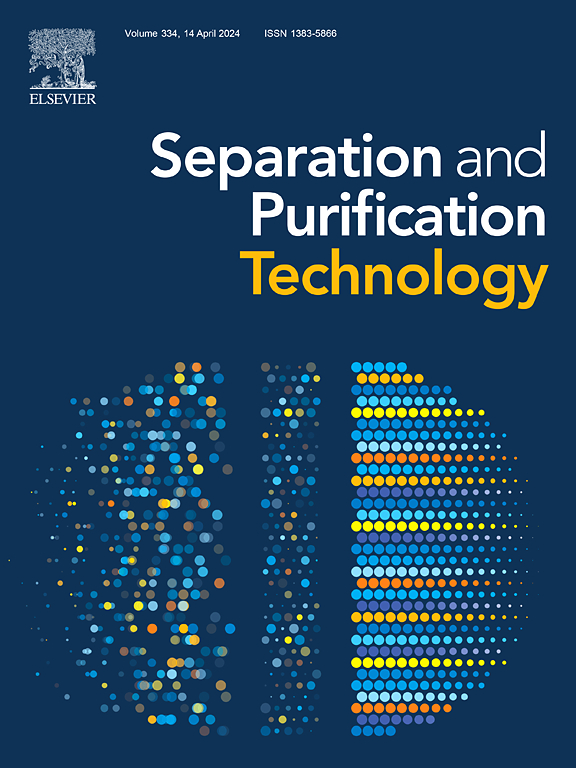Membrane fouling analysis and chemical cleaning optimization via membrane autopsy for membrane bioreactor from lab to engineering application
IF 8.1
1区 工程技术
Q1 ENGINEERING, CHEMICAL
引用次数: 0
Abstract
Chemical cleaning is critical to maintain the long-term stable membrane filtration for membrane bioreactor (MBR) process. Membrane fouling analysis is the prerequisite for optimizing chemical cleaning. Membrane autopsy including scanning electron microscopy with energy disperse spectrum (SEM-EDS), attenuated total reflection Fourier transform infrared spectrum (ATR-FTIR), front-face fluorescence excitation-emission matrix (FF-EEM) and specific clean water flux (SCWF) was employed in this study to reveal the combined organic–inorganic-biological fouling of hollow fiber ultrafiltration membrane from a large MBR plant, where average 160k m3/d mixed municipal (85%) and industrial (15%) wastewater was treated. The lab-scale fouled membrane cleaning tests showed that the optimal concentration of sodium hypochlorite (NaClO) was active chlorine of 2400 mg/L with pH of 11 and the optimal cleaning time was 12 h, the optimal concentration of oxalic acid (H2C2O4) was 10 g/L (equivalent pH of 1.42) and the optimal cleaning time was 8 h, and the optimal cleaning sequence was H2C2O4 followed by NaClO. H2C2O4 cleaning mainly removed inorganic foulants and destroyed the connection between inorganic substances and organic substances, which was beneficial to the effective removal of organic-biological foulants by the following NaClO cleaning. The engineering-scale cleaning test in a 300 m3 membrane tank in the MBR plant demonstrated that the above-mentioned optimal cleaning was superior to the routine cleaning of NaClO followed by citric acid (C6H8O7), the reagent cost was reduced by 43.1%, and the cleaning time was reduced by 37.5%. Thus, NaClO should be the dominant cleaning reagent and acid cleaning should be implemented before NaClO cleaning if necessary. The SCWF measurement revealed that the upper membrane unit suffered less fouling due to its lower flux caused by more sludging in membrane fibers than the lower membrane unit in double-deck cartridge. Therefore, air scouring along membrane fibers should be uniformly distributed especially for the upper membrane unit to release its filtration capacity.


从实验室到工程应用的膜生物反应器,通过膜解剖分析膜污染及化学清洗优化
化学清洗是膜生物反应器(MBR)过程中维持膜过滤长期稳定的关键。膜污染分析是优化化学清洗的前提。采用扫描电镜能谱(SEM-EDS)、衰减全反射傅立叶变换红外光谱(ATR-FTIR)、正面荧光激发发射矩阵(FF-EEM)和特定净水通量(SCWF)等膜解剖技术,揭示了某大型MBR装置中空纤维超滤膜的有机-无机-生物复合污染。平均处理160k m3/d的混合城市(85%)和工业(15%)废水。实验室规模污膜清洗试验表明,次氯酸钠(NaClO)的最佳浓度为活性氯2400 mg/L, pH = 11,最佳清洗时间为12 h;草酸(H2C2O4)的最佳浓度为10 g/L(等效pH = 1.42),最佳清洗时间为8 h;H2C2O4清洗主要去除无机杂质,破坏了无机物与有机物之间的联系,有利于后续NaClO清洗有效去除有机-生物杂质。在MBR装置300 m3膜槽中进行的工程规模清洗试验表明,该优化清洗方案优于NaClO +柠檬酸(C6H8O7)常规清洗方案,试剂成本降低43.1%,清洗时间缩短37.5%。因此,应以NaClO为主要清洗试剂,必要时应在NaClO清洗前进行酸洗。SCWF测量结果表明,由于膜纤维中的污泥较多,上层膜单元的通量较低,因此上层膜单元比下层膜单元受污染较少。因此,应使沿膜纤维冲刷的空气均匀分布,特别是使上膜单元释放其过滤能力。
本文章由计算机程序翻译,如有差异,请以英文原文为准。
求助全文
约1分钟内获得全文
求助全文
来源期刊

Separation and Purification Technology
工程技术-工程:化工
CiteScore
14.00
自引率
12.80%
发文量
2347
审稿时长
43 days
期刊介绍:
Separation and Purification Technology is a premier journal committed to sharing innovative methods for separation and purification in chemical and environmental engineering, encompassing both homogeneous solutions and heterogeneous mixtures. Our scope includes the separation and/or purification of liquids, vapors, and gases, as well as carbon capture and separation techniques. However, it's important to note that methods solely intended for analytical purposes are not within the scope of the journal. Additionally, disciplines such as soil science, polymer science, and metallurgy fall outside the purview of Separation and Purification Technology. Join us in advancing the field of separation and purification methods for sustainable solutions in chemical and environmental engineering.
 求助内容:
求助内容: 应助结果提醒方式:
应助结果提醒方式:


